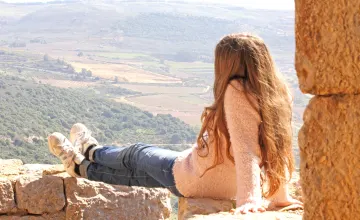Flora and Fauna
Golan Heights travel guideThe Golan, synonymous in the Bible (along with the Bashan) with a heavily wooded area, was still covered with dense woods and forests in the recent past. Unfortunately, those forests have been cleared for agriculture and grazing over the last few generations, but in the northern part of the Golan and in copses and thickets in the south, the endemic trees of the region can still be seen. The oak
and terebinth forests of the Golan give rise to an impressive landscape, the numerous deciduous trees lending the terrain a European feel in the winter. In the late winter and spring, the ground between the trees is covered with blossoms from the rarest of orchids to anemones, tulips, and a patchwork of other wildflowers, some of Them unique to the Golan. On the upper slopes of the Hermon range, alpine meadows and vegetation can be found. There the flowers bloom in early summer, in contrast to the winter florescence in the rest of Israel, making the Hermon a unique destination for nature lovers.
The wildlife of the Golan is the most varied in Israel. The human population on the Golan is sparse, the region has relatively large open areas, and significant segments of it have been declared nature reserves. The Golan is a meeting place for fauna that migrates north along the Syrian-African rift from Africa and the desert areas, fauna that makes its way westwards across the steppes of Asia, and European fauna that arrives from the north.
Fifteen species of fish swim in the rivers and ponds of the Golan, while seven species of amphibians and thirty-five different kinds of reptiles (only one of them poisonous!) populate their banks. Millions of birds fly over the Golan during their biannual migration from Europe to Africa and back: one hundred
vulture couples nest in the Gamla Nature Reserve, together with eagles and other raptors.
The Golan is home to thousands of gazelles, rock rabbits, hyenas, wild boars, foxes, and even a rare subspecies of wolf unique to the Golan. They cohabit with badgers, jackals, wildcats, and an extremely uncommon leopard or two. Seventy years ago Mount Hermon was still home to the Asian brown bear, but none have been sighted for three generations now.
https://www.inisrael.com/golan/flora.htm






